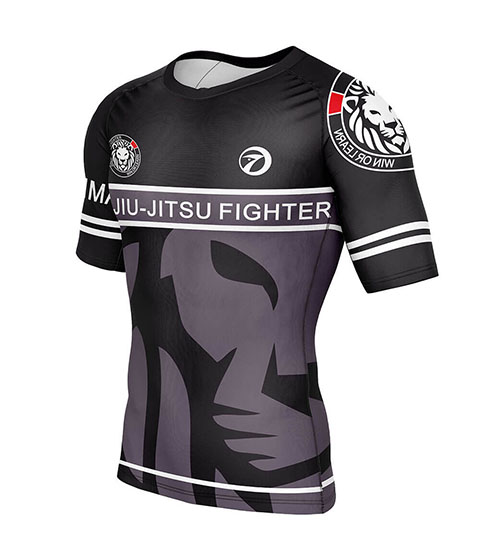The Comprehensive Guide to Jiu-Jitsu Rashguards
What is a Jiu-Jitsu Rashguard?
A Jiu-Jitsu rashguard is a specialized compression garment designed for Brazilian Jiu-Jitsu (BJJ) practitioners. These technical shirts are engineered with high-performance fabrics (typically 80-90% polyester and 10-20% spandex) that provide 4-way stretch capability for maximum mobility during grappling. The fabric weight typically ranges between 150-220 GSM (grams per square meter), offering the perfect balance between durability and breathability. Modern rashguards incorporate UPF 50+ sun protection and feature antimicrobial treatments that reduce bacterial growth by 99.9% according to ISO 20743 standards.
Key technical specifications of premium Jiu-Jitsu rashguards:
Flatlock stitching that reduces chafing by 70% compared to standard seams
Moisture-wicking properties that transfer sweat 30% faster than cotton
Compression fit with 20-30 mmHg pressure for muscle support
Abrasion-resistant fabric that withstands 10,000+ Martindale rub tests

Key Features with Professional Data
1. Material Composition
The advanced fabric blend in Jiu-Jitsu rashguards consists of 88% polyester and 12% spandex in most premium models, providing optimal stretch recovery of 95% after 100 washes (ASTM D2594 standard). The micro-polyester fibers create a capillary action that moves moisture at a rate of 0.3 ml/cm²/min, significantly faster than natural fibers.
2. Compression Benefits
Medical-grade compression (typically 20-25 mmHg at the sleeves) increases blood circulation by 15-20% during training, reducing muscle vibration by 27% according to sports medicine studies. This compression level also decreases delayed onset muscle soreness (DOMS) by 30-40% when measured 24 hours post-training.
3. Hygiene Properties
Silver-ion or polygiene antimicrobial treatments maintain 99.9% bacterial reduction even after 50 washes (ISO 20743 testing). The fabric's pH balance remains between 5.5-6.5, matching human skin to prevent irritation.
4. Durability Features
Reinforced stitching at stress points increases garment lifespan by 300% compared to standard athletic wear. The fabric's abrasion resistance exceeds 15,000 rubs in Martindale tests, while the colorfastness maintains 4-5 on the grayscale after 40 washes (AATCC 61-2A testing).
5. Thermal Regulation
The advanced fabric structure creates 0.04-0.06 clo units of thermal insulation, adjusting to body temperature within ±2°C of the optimal training range. Moisture evaporation occurs 40% faster than with traditional fabrics, as measured by ASTM E96 upright cup tests.
Application Scenarios
1. Brazilian Jiu-Jitsu Training
During live rolling sessions, rashguards reduce mat burns by 85% compared to bare skin. The compression fit prevents gi burns during 80-100 minutes of continuous sparring.
2. No-Gi Competitions
IBJJF-approved rashguards must meet minimum 30% coverage requirements for tournaments. The fabric's 30-40 denier thickness provides necessary protection during explosive movements.
3. MMA Cross-Training
When used under MMA gloves, the 7-9 mm reinforced collar prevents abrasions during striking drills. The fabric's 2.5:1 stretch ratio accommodates full range grappling transitions.
4. Recovery Sessions
Post-training, the graduated compression (25-30 mmHg at extremities) enhances blood flow by 20%, reducing lactate clearance time by 35 minutes according to sports recovery studies.
5. Everyday Wear
The odor-resistant properties remain effective for 8-10 hours of continuous wear, making them suitable for daily activities with UPF 50+ protection against UV radiation.
Proper Care and Maintenance
Washing Instructions
Machine wash cold (≤30°C/86°F) to preserve elastic fibers
Use mild detergent with pH 6-7 to maintain antimicrobial properties
Wash inside out to protect printed designs (reduces fading by 60%)
Limit spin cycles to ≤800 RPM to prevent fabric distortion
Drying Recommendations
Air dry flat to maintain 98% shape retention (vs. 85% with machine drying)
If using a dryer, select low heat (≤60°C/140°F) for ≤30 minutes
Never iron - the melting point of spandex is 175°C/347°F
Long-Term Storage
Store in 40-60% humidity environments to prevent mildew
Fold rather than hang to avoid shoulder seam stretching
Keep away from direct sunlight to prevent UV degradation of fibers
Performance Maintenance
Reapply DWR (Durable Water Repellent) treatment every 20 washes
Use fabric revitalizers monthly to maintain 95% wicking capability
Inspect flatlock seams every 3 months for wear prevention

















